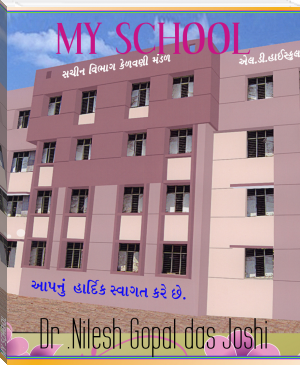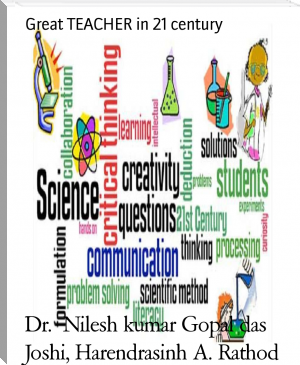MY SCHOOL by Dr .Nilesh Gopal das Joshi (beginner reading books for adults .txt) 📕

- Author: Dr .Nilesh Gopal das Joshi
Book online «MY SCHOOL by Dr .Nilesh Gopal das Joshi (beginner reading books for adults .txt) 📕». Author Dr .Nilesh Gopal das Joshi
Steps involved in Institutional Planning
Identifying the needs of the institution Pooling together the resources of the institutions Preparing a plan for action Implementing the plan Evaluating and taking the corrective actionsStep 1: Analysis of the present situation
Make an analysis of the present position. The staff will analyze the present situation with respect to the needs. The headmaster will constitute a planning council for this purpose. This council may be asked to prepare the blueprint of the plan which may be finalized later. The authorities will have to analyze the present situation. The Principal will hold a meeting and review whether:
The school building is spacious enough to cope with present needs The equipment and furniture are adequate The available staff is adequate The existing institutional programmes requires reshuffling and change The library and lab facilities are adequate The examination system needs reform The admission procedure needs any reform. The institution needs additional facilities and provisions like play grounds, hostel, staff quarters, canteen, boundary wall etc. The last years’ institutional plan should continue.Step 2: Survey of the resources
Make a survey of resources. The principal and the staff of school should make a survey of the existing resources as well as the resources that can be made available. Facts and figures regarding student enrollment, staff, building, equipment, books, examination results etc. should be tabulated for ready reference. There are three categories of resources to be surveyed and examined:
Resources available in the school, Resources easily available through the government, management and School Education Board, Resources available in the community like public library, museum, health center, playground, gymnasium, swimming pool, assembly hall, auditorium, workshop, technical institutions, children’s park, local doctors, engineers, educationists and other useful persons residing in the locality.The survey of the resources gives the institution an idea of the resources, their utilization in the past and their better utilization in the present situation. Places of educational, scientific, geographical, historical, social and general interest in the locality must be visited by the teachers and students. Doctors, retired teachers, military personnel may be requested to deliver lectures to the students and parent-teacher associations. Appeal may be made to well-to-do parents to help the school in various ways. Parent-teacher associations have always helped in school improvement in the form of providing conveyance to the students, adding to school accommodation, providing fans in classrooms, providing books to library etc.
Step 3: Improvement programmes
In the light of survey of the existing situation, survey of the felt needs and survey of resources available, the school may draw a priority-wise list of improvement programmes. Improvement programmes can be classified into short term and long term programmes.
Each improvement programme needs to be defined in terms of:
Utility for the institution Financial implications if any Action research should be done immediately. Project concerning building Project concerning Campus and equipments Project concerning instructional materials Projects concerning pupil welfare Library projects etc.The improvement programmes will take the form of school development programmes and action research activities. These programmes can be started immediately from the view of urgency of the problem. Each programme and action research investigation must have some broad objectives and some specific objectives. The objectives must be stated in clear terms. These programmes must further be resolved into specific tasks and each task must be elaborated in respect of the resources, time, procedure, output, utility and evaluation.
A schedule can be drawn up to fulfil the requirements of institutional planning which includes:
Name of the programme Annual grant available Objectives Specific tasks Teachers in charge Sample involved Time schedule Methods and techniques Conclusions Evaluation Follow-upIn this way, a school can build a task-oriented plan for actual execution and implementation to meet the actual needs and solve the actual problems of the school. The entire school population must become plan-mindedand all programmes for the year must be preplanned utilizing the existing material and human resources to the maximum.
Suggestions for school development programmes
Additional accommodation Petty repairs Electrification and sound system Provision of drinking water facilities Toilet, sewage, sanitary and drainage facilities Playgrounds, lawns Beautification of campus Blackboards and illustrative aids Co-operative store Co-operative bank Cleanliness campaign School calendar Scientific hobbies Student’s self-governmentSuggestive investigations for Action Research
Bad hand writing and spellings Irregular homework Bad computational skills Truancy and indiscipline Poor participation in games Stagnation and wastage Various techniques for improvement in learning Improvement in human relations in school Grammatical mistakes and their correction Special programmes for slow learners and giftedStep 4: Implementing the development programme
The staff will make a selection of the programmes that are to be undertaken during the enduring session and prepare full length outline of the same. After that the plans have to be executed according to the resources available and the procedures outlined. The execution must be done through the co-operation of all. The responsibilities must be shared between headmaster, teachers, students and members of the community. There will be division of labour according to the suitability and choice of the individuals.
Committees of the staff members will be formed to carry out various programmes under the plan. A time schedule for the progress of the plans will also be prepared to ensure time-bound completion.
Step 5: Evaluation of the plan
At the completion of the programme, the results must be assessed quantitatively and qualitatively. A schedule can be prepared:
Name of programme Annual grant available Objectives Specific task Period of completion Teacher-in-chargeIt will have to be seen whether the objectives envisaged in the beginning of the plan have been achieved or not. If achieved, to what extent it is achieved. Some of the unachieved or partially achieved objectives will overflow to the next institutional plan. Anything left undone will form the basis for follow-up and future plans.
The school community will have self-evaluation in respect of targets achieved, efficacy of procedures and difficulties experienced. It has to be done frequently leading to modifications to make the plan more practicable and useful.
The supervisors and subject experts at the district headquarters will evaluate the programmeatleast once in a year or more frequently if possible. The evaluation will be made in terms of the extent of contribution of creative ideas in planning, resourcefulness shown in implementation, the number of people involved, full and partial achievements and difficulties experienced.
At this stage of evaluation good work done by various individuals at different levels for successful completion of the plan should be recognized.
Merits of Institutional Planning
Helps in achieving educational objective Helps in achieving institutional planning Reduces future uncertainty Facilitate control Improves the infrastructure Facilitate decision making Improve standard of institution Chapter: 14 School Management Committee (SMC)School Management Committee (SMC)
School management committees or SMCs build a critical bridge between the community and the schools, playing the additional role of providing oversight in school to ensure all basic requirements of the school are being met as per the right to educational guide lines in 2009.
Parental involvement in children’s education is largely believed to lead to improved learning outcomes. The level of involvement can vary from providing a secure home for children, maintaining a healthy parent- teacher communication and parents volunteering to involve in the governance of the school.
The abbreviation SMC stands for School Management Committee. The RTE act, 2009 has come into force with effect from 1st April, 2010 in our country which is a landmark in the history of education. Efficient provisions regarding constitution and functions of SMCs have been given in section 21 and 22 of the right of children to free and compulsory education act 2009. SMC is formed to plan, monitor and implement schemes as per the right of children to free and compulsory education (RTE) Act of 2009.
SMC shall be constituted in every government and aided school and reconstituted every two years, according to the RTE act of 2009.SMC shall play important role for effective development of a school.
Roles and Functions of the SMC as envisaged under the RTE Act, 2009
The RTE Act, 2009 has come into force with effect from 1st April, 2010 in ourcountry which is a landmark in the history of education. The said Act assigns immenseimportance to School Management Committees as a part of decentralized structure to ensurethe effective and regular functioning of the schools and education center, and one in whichthe parents will have a preponderance. Essential provisions regarding constitution andfunctions of SMCs have been given in section 21 and 22 of the Right of Children to Free andCompulsory Education Act, 2009.
Section 21
A school, other than a school specified in sub-clause (IV)of clause (n) of section 2,shall constitute a School Management Committee consisting of the electedrepresentatives of local authority, parents or guardians of children admitted in suchschool and teachers:Provided that at least three-fourth of members of such committee shall be parents orguardians:
Provided further that proportionate representation shall be given to parents orguardians of children belonging to disadvantaged group and weaker section;
Provided that fifty percent of members of such committee shall be women.
The School Management Committee shall perform certain functions, namely: - a) Monitoring the working of the school; b) Preparing and recommend school development plan; c) Monitoring the utilization of the grants received from the appropriateGovernment or local authority or any source; and
d) Performing such other functions as may be prescribed.Section 22
Every School Management Committee constituted under sub-section (l) of section 21shall prepare a School Development Plan in such a manner as may be prescribed. The School Development Plan so prepared under sub-section (1) shall be the basis forthe plans and grants to be made by the appropriate Government or local authority asthe case may be.It is obvious that majority of SMC members are the parents/guardians of thosechildren who are studying in the school. Chairperson of the SMC shall also be a parent/guardian. Bank account of SMC is maintained by joint signature of chairperson and membersecretary (Headmaster). Representation of the socially backward parents and electedrepresentatives of Gram Panchayat in SMC shall play important role for effectivedevelopment of a school. SMC has many functions as enrolment, retention, completion ofelementary education with quality for all children residing in catchment area of school andpreparation of school development plan.
As per responsibility given in The RTE Act it ismandatory and important to aware SMC members regarding the roles and functions throughorientations/trainings. Unless the members of the SMC (Chairperson, member secretary, localrepresentative and other members) are aware of the main provisions of RTE, objectives,composition and their role and functions, they cannot contribute for effective development ofa school and to achieve objectives of RTE provisions regarding SMC.
When community and local bodies are empowered to function for the development ofElementary Education, much improvement could be seen in academic and non- academicareas. They are the ones who can assist the problems faced by schools. So, several studieshave been conducted on community involvement in the management of elementary schools.
Functions of School Management Committee
Monitor the working of the school Monitor the enrollment and attendance of all children from the neighborhood Prepare and recommend school development plan Monitor the identification and enrollment of disabled children, and ensure that they are provided with facilities and materials till completion of elementary education Monitor the implementation of Mid-Day Meal and other government school schemes Monitor the maintenance of norms and standards prescribed in the schedule which would include classrooms, school facilities, teacher pupil ratios, etc. Monitor the attendance and punctuality of teachers Ensure 100% enrollment of children in the age group of 6-14 yearsStructure of SMC
Parents from all sections of the society: RTE act suggest that 75% of the SMC must be composed of parents or guardians Elected members of the local authority: It should include some elected members of the local committee Teachers from the school: Teachers should be nominated by the headmaster since they act as liaison between parents




Comments (0)